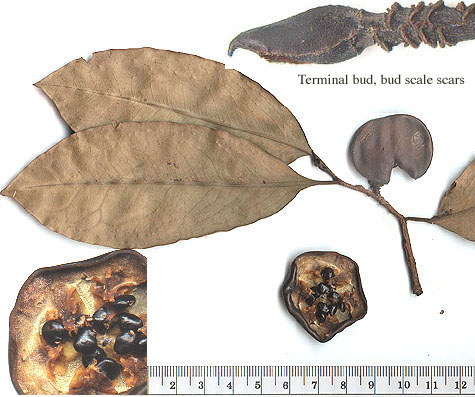| |
 Main |
Family List (MO) |
Family List (INBio) | Cutting Edge
Main |
Family List (MO) |
Family List (INBio) | Cutting Edge
Draft Treatments |
Guidelines | Checklist | Citing | Editors
The Cutting Edge Volume VI, Number 1, January 1999
News and Notes | Recent Treatments | Leaps and Bounds | Germane Literature
BIGNONIACEAE. Tynanthus croatianus A. H. Gentry becomes a former
Panamanian endemic following collections by Francisco Morales and
former parataxonomist Sary Rojas from the Carara Reserve and near
Boruca, respectively, at 200--400 m.. Credit for the determination and
thanks for the report go to Chico.

CANELLACEAE. Canellaceae!?!? One of co-PI Barry Hammel's trademark leaps of the
imagination has resulted in this most unexpected identification of a mystery
tree recently collected by Reinaldo Aguilar on the Península
de Osa. Reinaldo's material, in fruiting condition, had been puzzling all
of us since the Taller de Plantas sessions last summer, when families such
as Annonaceae and Ebenaceae were considered and rejected. If this new identification
proves correct, as appears virtually certain, this would be the first Mesoamerican
record for the family. Although the generic affinity of Reinaldo's collection
remains conjectural, suspicion centers on the monotypic, Caribbean Pleodendron
and the oligotypic, South American Cinnamodendron. In either case,
ours (noteworthy for its unusually large fruits) would figure to be a new
sp. Only flowers are needed!
DIOSCOREACEAE. A collection made in 1977 by MO Araceae stalwart Thomas
B. Croat has been identified by specialist Oswaldo Téllez
(MEXU) as Dioscorea composita Hemsl., not otherwise known from south
of El Salvador (annotate your copy of Flora mesoamericana!). Tom's
specimen comes from 850 m elevation near Zarcero, Prov. Alajuela.
GROSSULARIACEAE. According to colleague Francisco Morales, Phyllonoma
latiscuspis (Turcz.) Engl., sometimes regarded as a synonym of P.
ruscifolia Willd. ex Schult., is widely distributed in the Cordilleras
de Guanacaste and Tilarán. This sp. was previously known only from
Mexico to Honduras.
LEMNACEAE. A generous, as yet unmounted collection prepared in 1982 by
Luis Diego Gómez proves to be the first record of Spirodela
punctata (G. Mey.) C. H. Thomps. for the entire Mesoamerican region,
between Texas and Colombia (as far as we are able to establish). The material
was gathered at 1700--1800 m elevation (the highest station for the family
in Costa Rica) in the Candelaria region, south of San José, in Prov.
Cartago. Costa Rica can now boast all three spp. of Spirodela.
The native range of the cosmopolitan S. punctata is supposedly limited
to the southern hemisphere and east Asia, although it has been widely introduced
elsewhere, e.g., in North America, Europe, and North Africa. The status
of the Costa Rican population is entirely ambiguous.
MALVACEAE. Contributor Paul Fryxell (TEX) reports five country records,
to be added to his submitted Manual treatment. Abutilon purpusii
Standl., formerly known only from Mexico and Guatemala, has now been collected
from 1900 m elevation on Cerro de La Muerte, while the South American A.
striatum Dicks. ex Lindl. is vouchered from 1200 m in the Cerros
de Escazú. The latter sp., the "flowering maple" of the
horticultural trade, is presumably naturalized in Costa Rica. A specimen
collected by veteran parataxonomist Ulises Chavarría in Parque
Nacional Palo Verde is the first Central American record for Allosidastrum
interruptum (Balb. ex DC.) Krapov., Fryxell & D. M. Bates,
otherwise known only from western Mexico and the Santa Marta region of Colombia.
Parataxonomist Marcos Moraga's collection of Malvaviscus achanioides
(Turcz.) Fryxell, from 1700--1845 m elevation on the Pacific slope of the
Cordillera de Talamanca, is the first from south of Honduras. Finally,
Pavonia corymbosa (Sw.) Willd., recently segregated by Fryxell from
P. paniculata Cav., is a taxonomic rather than a geograpical leap;
a less inclusive P. paniculata also occurs in Costa Rica.
THYMELAEACEAE. Daphnopsis hammelii Barringer & Nevling may be
recorded as new to Costa Rica, but there is a tradeoff; see under "Treatments
Recently Received" for further details.
| |

